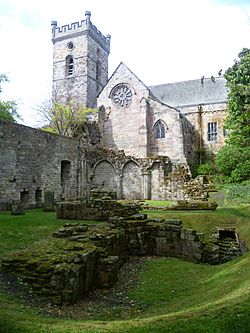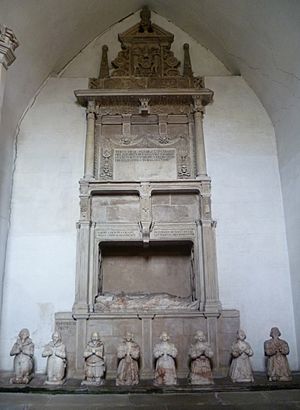Culross Abbey facts for kids
 |
|
| Monastery information | |
|---|---|
| Order | Cistercian |
| Established | 1217 |
| Disestablished | 1589 |
| Mother house | Kinloss Abbey |
| Diocese | Diocese of St Andrews |
| Controlled churches | Crombie; Culross; Tullibole |
| People | |
| Founder(s) | Maol Choluim I, Earl of Fife |
Culross Abbey is an old monastery in Culross, Scotland. It was once home to Cistercian monks and led by a person called an Abbot. Today, part of the abbey is still used as the local church by the Church of Scotland.
Contents
A Look Back: The Abbey's History
How Culross Abbey Began
The abbey was started in 1217 by Malcolm I, who was the Earl of Fife. The first monks who lived there came from Kinloss Abbey. Culross might have been chosen for the abbey because it was the birthplace of Saint Mungo.
It seems the abbey was built on top of an even older church. This earlier church was thought to be started by Saint Serf in the 500s. We know this from old carved stones found at the site and from old writings that mention a church of St Serf in Culross.
Changes Over Time
The abbey, built in the 1200s, was shaped like a cross. By the late 1400s, there were fewer monks living there, only about 15. Because of this, some parts of the monastery were no longer used. The front part of the church was even taken down around 1500.
In 1560, a big change happened in Scotland called the Reformation. This made monastic life illegal. The abbey was allowed to continue, but no new monks could join. The plan was for it to close when the last monk died. In the 1580s, local people started using the old east end of the abbey for their church services.
Important Burials and Restorations
In 1613, something unusual happened. The heart of Edward Bruce was buried in the churchyard. He was killed in a duel. His heart was placed in a silver box.
By 1633, the east end of the abbey church was officially taken over as a parish church. The other buildings of the abbey slowly fell apart. In 1642, the north side of the church was turned into a special tomb house by Sir George Bruce of Carnock. You can still see statues of him, his wife, and their eight children there today.
The abbey was fixed up in 1823, but some original parts were removed. Another big restoration happened in 1905. This time, the missing parts were put back, making the buildings look much like they do today. The eastern parts of the church are still used for worship and are usually open for visitors to see.
The Legend of the Piper
There's a cool old story about a secret tunnel under the abbey. People say a man sits in a golden chair inside, waiting to give treasures to anyone who finds him. One story tells of a blind piper who tried to find him. He went into the tunnel with his dog, playing his pipes. People could hear his music far away. But only his dog came out. The piper was never seen or heard from again!
Culross Abbey Today
The parts of the abbey that are now ruins are looked after by Historic Environment Scotland. The part of the Abbey that is still standing is used by the Church of Scotland as the local church. Inside the church, you can see beautiful stained glass windows. Some are old, and some are more modern.
The Abbey has also been used for fun events, like concerts.


